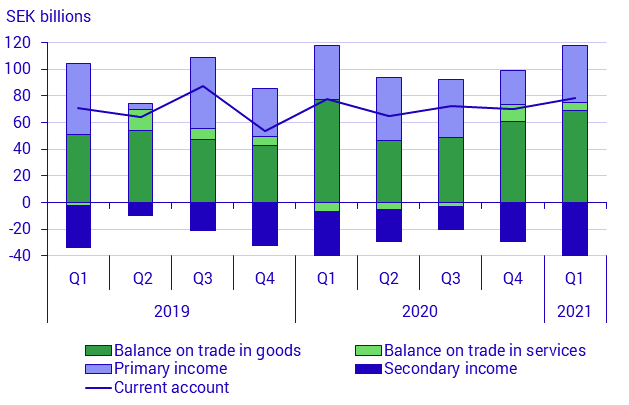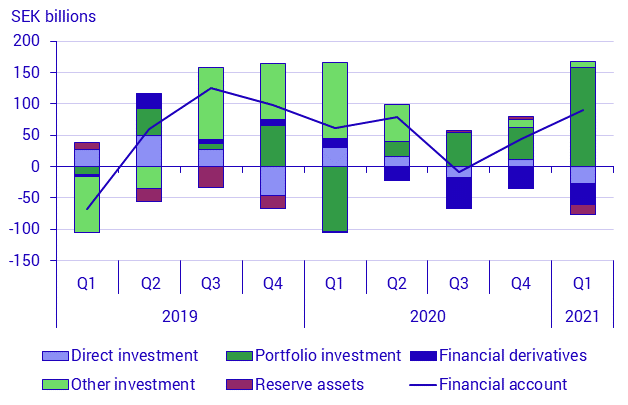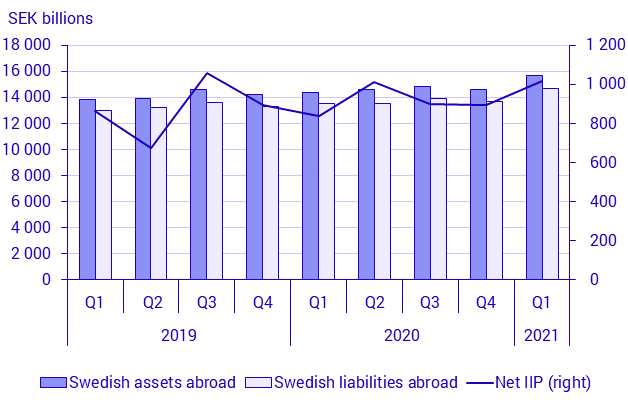Balance of payments, 1st quarter 2021
Current account unchanged in the first quarter
Statistical news from Statistics Sweden 2021-06-04 9.30
The current account surplus was SEK 78.3 billion in the first quarter of 2021, which is on a level with the first quarter of 2020, when the surplus was SEK 77.9 billion. Trade in services noted an increased surplus, which was offset by trade in goods and secondary income.
The financial account noted net lending with the rest of the world amounting to SEK 90.8 billion in the first quarter. Sweden’s net external assets position, presented in the international investment position, was SEK 1016.6 billion at the end of the first quarter of 2021.
What is the balance of payments?
The balance of payments is a statement of all Swedish transactions with the rest of the world. It presents exports and imports of goods and services, and includes a description of changes in financial assets and liabilities with the rest of the world. The balance of payments consists of the current account, the financial account, and the capital account. The component parts of the balance of payments and related terms are explained under Definitions and explanations, at the end of this item of statistics news.
Current account surplus as share of Sweden’s GDP remained unchanged
Sweden’s current account as a share of the GDP has remained at the same level compared with the last quarter, and amounted to 5.7 percent of Sweden’s GDP in the first quarter of 2021, calculated as an average over the last four quarters. This share has remained at similar levels since the fourth quarter of 2019.

Comparisons between periods in the current account are made using the corresponding quarter the previous year.
Trade in goods surplus decreased
The balance on trade in goods recorded a surplus of SEK 69.1 billion in the first quarter of 2021, which is a decrease of SEK 8.0 billion compared with the first quarter of 2020. Goods exports amounted to SEK 433.5 billion, down by SEK 0.4 billion compared with the corresponding quarter a year ago. Goods imports amounted to SEK 364.4 billion, which is an increase of SEK 7.5 billion in a corresponding comparison. Rising imports combined with relatively unchanged exports led to a weaker balance on trade in goods.
Surplus in merchanting, which is included in the balance on trade in goods, decreased by SEK 0.3 billion compared with the first quarter of 2020. The surplus thus amounted to SEK 37.6 billion in the first quarter of 2021.
Services account surplus increased
The services account noted a surplus of SEK 5.8 billion. This can be compared with a deficit of SEK 6.8 billion in the corresponding quarter last year. Services exports amounted to SEK 151.2 billion, down by SEK 13.3 billion compared with the first quarter of 2020. At the same time, import of services amounted to SEK 145.3 billion, down by SEK 26.0 billion in a corresponding comparison. Services imports decreased more than exports on services, which led to a strengthened services account.
Primary income surplus increased
Primary income, which consists mainly of compensation of employees and investment income, noted a surplus of SEK 43.2 billion in the first quarter of 2021. This surplus increased by SEK 2.6 billion compared with the corresponding quarter a year ago. Return on capital is the part of primary income that mainly contributed to this change through an increased surplus. The surplus in return on capital went from SEK 35.9 billion in the first quarter of 2020 to SEK 39.7 billion in the first quarter of 2021.
Investment income on direct investment contributed a surplus of SEK 21.3 billion, which is an increase of SEK 3.2 billion in a corresponding comparison. Portfolio investment contributed a surplus of SEK 20.7 billion to investment income, up by SEK 2.5 billion compared with the corresponding quarter a year ago.
Secondary income deficit increased
Secondary income, which includes international cooperation and contributions to the EU, presented a deficit of SEK 39.8 billion. This deficit increased by SEK 6.8 billion compared with the corresponding quarter a year ago.
Net lending in the financial account
The financial account recorded net lending amounting to SEK 90.8 billion in the first quarter of 2021. Net lending and net borrowing refer to the overall balance on the financial account.
In the financial balance, portfolio investment and other investment noted net lending, while financial derivatives and direct investment noted net borrowing. Net lending for the reserve assets decreased in the first quarter of 2021.

Direct investment increased both in Sweden and abroad
Net borrowing in direct investment amounted to SEK 26.8 billion during the quarter. Foreign direct investment in Sweden increased by SEK 80.7 billion, while Swedish direct investment abroad increased by SEK 54.0 billion.
Swedish portfolio investment abroad increased
Net lending in portfolio investment amounted to SEK 158.6 billion during the quarter. Swedish investors increased their portfolio investment abroad by SEK 129.1 billion, while foreign investors decreased their portfolio investment in Sweden by SEK 29.5 billion.
Other investment increased both abroad and in Sweden
Net lending in other investment corresponded to SEK 9.5 billion. Foreign other investment in Sweden increased by SEK 232.6 billion and Swedish other investment abroad increased by SEK 242.1 billion.
Financial derivatives and reserve assets
Net borrowing in financial derivatives amounted to SEK 34.1 billion. Reserve assets noted decreased net lending corresponding to SEK 16.5 billion.
Net assets in Sweden’s international investment position increased
Sweden’s net external assets position amounted to SEK 1 016.6 billion, which is an increase compared with the previous quarter, when net assets amounted to SEK 895.7 billion. Portfolio investment is the part that contributed the most to the increase through decreased net assets.

Comparisons between periods in the international investment position are made using the previous quarter.
Swedish external liabilities increased
Swedish external liabilities increased by SEK 979.1 billion compared with the previous quarter and amounted to SEK 14 651.7 billion. Portfolio investment, followed by other investment, was the largest contributor to the increase, while direct investment noted a small increase. This was offset by a small decrease in financial derivatives.
Swedish external assets increased
Swedish external assets increased by SEK 1 100.0 billion compared with the previous quarter and amounted to SEK 15 668.3 billion. The change is largely due to increased assets in portfolio investment, followed by other investment and direct investment. Financial derivatives decreased and reserve assets noted, in this context, a minor decrease.
Sweden’s largest net external assets are in direct investment
Direct investment, reserve assets and other investment accounted for the largest net external assets. The largest net liabilities were in portfolio investment.
Revisions
The time series for the Balance of Payments and the international investment position has been revised from Quarter 1 2017.
The Balance of Payments adheres to a predetermined revision policy, see Section 2.3 in the "Kvalitetsdeklarationen 2021 (pdf)".
In a compilation of the balance of payments and the international investment position, data based on forecasts is used in some cases. The statistics will be updated as results are received. If new data is added or in the case of any methodological changes, further revisions are carried out as necessary.
Revisions carried out in connection with publication of the first quarter 2021 are listed in the tables on revisions by account item for the balance of payments and the international investment position, respectively.
Definitions and explanations
The current account and the financial account record real and financial transactions with regard to the rest of the world. Only proper transactions are recorded; value changes, such as exchange rate fluctuations are excluded.
The current account shows the trade in goods (foreign trade in goods), the trade in services (foreign trade in services), primary income (compensation to employees, investment income, other primary income), and secondary income (current transfers). Surplus and deficit in the current account refer to the difference between Sweden’s exports and Sweden’s imports. A positive outcome results in a surplus, while a negative outcome results in a deficit. Comparisons between periods in the current account are always made using the corresponding quarter the previous year, due to seasonal patterns in data.
The financial account consists of direct investment, portfolio investment, financial derivatives, other investment, and reserve assets. Sweden can acquire and dispose of financial assets abroad. All transactions during the quarter concerning external assets show Sweden’s change in net external assets. Sweden can also borrow and repay financial external liabilities. All transactions during the quarter concerning external liabilities show Sweden’s change in net external liabilities. The difference between Sweden’s change in net external assets and Sweden’s change in net external liabilities can be positive or negative, and shows net lending and net borrowing, respectively.
The capital account records Sweden’s capital transfers and transfers of non-financial assets with regard to the rest of the world. Compared with other parts of the balance of payments, amounts in the capital account are usually small.
The difference between Sweden’s financial external assets and liabilities position is the net of Sweden’s international investment position, which can be positive or negative.
An increase or decrease in assets describes Sweden’s external assets. An increase or decrease in liabilities describes Sweden’s external liabilities.
Merchanting, which forms a part of the trade in goods, refers to triangular trade in which goods are purchased and sold abroad without the good crossing a Swedish border.
Statistical Database
More information is available in the Statistical Database
Feel free to use the facts from this statistical news but remember to state Source: Statistics Sweden.
